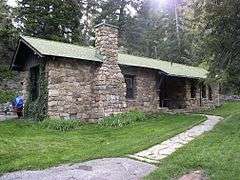Timpanogos Cave Historic District
|
Timpanogos Cave Historic District | |
|
Superintendent's residence | |
  | |
| Nearest city | Highland, Utah |
|---|---|
| Coordinates | 40°26′35″N 111°42′26″W / 40.44306°N 111.70722°WCoordinates: 40°26′35″N 111°42′26″W / 40.44306°N 111.70722°W |
| Area | 11 acres (4.5 ha) |
| Built | 1921-1941 |
| Architectural style | Rustic |
| NRHP Reference # | 82001760[1] |
| Added to NRHP | October 13, 1982 |
The Timpanogos Cave Historic District consists of support and administration buildings built in the 1920s and 1930s in Timpanogos Cave National Monument, Utah, USA. These structures are notable examples of the National Park Service Rustic style, designed to fit with their environment. The earliest trails and structures were built by Errol M. Halliday while the location was still under the administration of the U.S. Forest Service. The Old Cave Trail was built in 1921-22. The stone storage building was built in the 1920s, together with a frame custodian's residence that no longer exists. A stone confort station (Building 126) was built in 1928.[2]
The National Park Service took over the site in 1933. Park facilities were expanded using labor provided by the Works Progress Administration, with another comfort station (Building 127) in 1939. The American Fork River was diverted and a new bridge was built in the 1930s. The Superintendent's Residence was completed in 1941.[2]
Description
The structures are scatted on a steep landscape. The most significant building is the superintendent's residence, of rubble stone construction with a log-framed roof, covered with green shingles.The bridge is a single span built in 1935, using rubble stone. The 1935 Comfort Station restroom (presently named Last Chance restroom) is built on a ledge on the mountainside, and has a nearly flat concrete roof faced with stone. The 1928 comfort station is larger and built with a shingled roof. It is no longer used as a restroom. The rubble storage building is covered with a flat concrete roof. There are also two cold cellars on the site, both built about 1930. The trail climbs the cliffs for between one and 1.5 miles (2.4 km), its vertical climb of 1,065 feet (325 m) supported by stone retaining walls.[2]
The Timpanogos Cave Historic District was placed on the National Register of Historic Places on October 13, 1982.[1]
References
- 1 2 National Park Service (2010-07-09). "National Register Information System". National Register of Historic Places. National Park Service.
- 1 2 3 Culpin, Mary Shivers (February 10, 1982). "National Register of Historic Places Inventory - Nomination Form: Timpanogos Cave Historic District" (PDF). National Park Service. Retrieved 30 July 2012.
